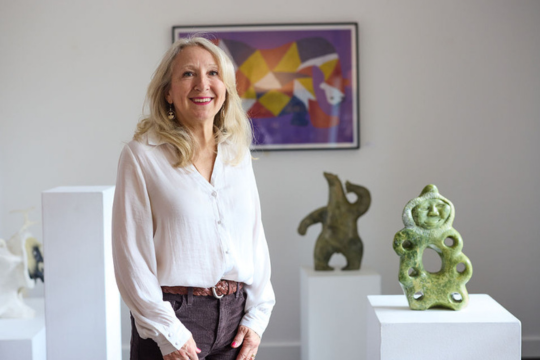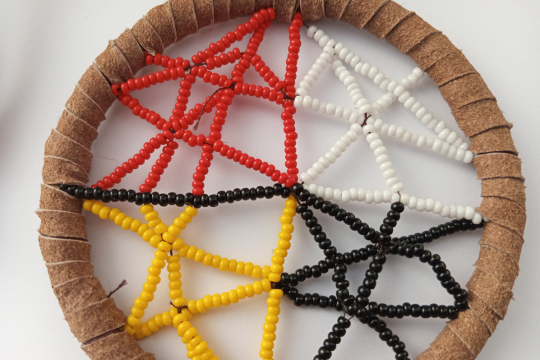
Cheryl Young didn’t grow up in an Inuit community, but as an adult, she’s embracing her culture and sharing it with her children. Photo: Kyla Zanardi
Cheryl Young didn’t grow up in an Inuit community, but her connection to her ancestry was fostered during summer trips to Nunatsiavut, when days were spent learning about Inuit lifestyle.
Hunting was a communal thing, she recalls. “You never had to worry about where your food came from,” says the Federal Retirees member who now lives in Valley, N.S.
These summers stood in contrast to her young life in Goose Bay, N.L., where there was no hunting and where she would be embarrassed to wear sealskin boots.
Today, however, it’s a different story. She embraces and shares her Inuit heritage and, as she’s now retired, she’s particularly aware of the teachings it provides on aging and how to treat the elder members of the community. In short, Inuit respect their elders.
The Algonquin approach
Peter Larivière, also a Federal Retirees member, was raised in his father’s Algonquin traditions.
“Aging doesn’t hold the same consequences within Algonquin tradition as it does in the way Western European-Canadians look at aging,” Larivière says. “Every person, every gender, including two-spirit people, all have a role to play.”
Near the end of his Parks Canada career, Larivière, who was careful to preface what he shared by saying he speaks only about the Anishinaabe and Ojibway lessons to which he has been exposed, became a mentor, and the advice he gave to colleagues could be useful for his fellow retirees.
“Be a bit selfish,” Larivière told them. “I don’t mean at the expense of others; but pay attention to yourself. By going outside, hearing birds and the wind blow through the trees, you can have that quiet time in your mind. As I get older, I get pissed off more easily, so having that chance to get back to being part of something bigger is important. That’s part of our teachings that gives us a benefit when things are going bad in our lives.”
Larivière says he’s been fortunate in terms of his health.
But in 2020, he was grappling with some mental health issues and found a therapist at the Wabano Centre for Aboriginal Health in Ottawa. “Some of the teachings and life experiences he [helped] me with went a long way to [understanding] myself as I was approaching retirement.”
Larivière points to the Algonquin medicine wheel that gives equal space to the four phases of life: the yellow of childhood, the red of youth, the black of midlife and the white of old age. His Indigenous experience describes the aging process as circular, rather than the linear way it is often described — with a beginning and an end. “You’re basically taught at a young age that there is
no power struggle [between] the age groups.”
Now as he ages, Larivière taps into the medicine wheel teachings often.
“I do wildlife photography,” he says.
“Now, when I’m out taking photographs, I say thank you — to a bird, to a landscape, to a moss-covered tree. I tend to think a lot more when I’m out. To me, that’s part of the aging process. It’s not thinking about being old, but thinking about life and what it’s meant to me. I’m more philosophical. That’s a way of life that’s more Indigenous: to consider your place within the sphere of the Earth.”
The medicine wheel’s role
Embracing reflection was explored in a recent webinar by Catherine Davis, an adjunct professor at Queen’s University with a PhD in Indigenous studies and a member of Alderville First Nation in southern Ontario. Davis described her presentation as a “Coles notes” of the Anishinaabe-Ojibway understanding of life’s phases. The medicine wheel served as a starting point. Davis explained that, according to the teachings, moving from one phase to another is like climbing a hill, with each stage offering unique experiences.

The medicine wheel gives equal space to the four phases of life: childhood, youth, mid-life and old age.
“The hills are a metaphor for obstacles and tests we will have throughout our life,” she says. “Sometimes the challenges may turn into traumas. It helped me to be a more compassionate person when I looked at the hills and imagined all the challenges that might occur getting up each individual hill.”
On the fourth hill, Davis explained, life slows down and it’s time for reflection. Old age is a gift, as it offers us a chance to ask ourselves: “Did we honour the gift of life?” Another aspect of this phase is the passing on of knowledge, and choosing what is worthy of being passed on. “With that knowledge we serve our community,” she says.
Since he turned 60 last year, serving one’s community has been top of mind for Elroy White, a chief of the Heiltsuk First Nation in British Columbia.
“I realized that I’m getting closer to the end of my life. But that made me more productive, not scared.”
With 19 years working as an archeologist in his community of Bella Bella, B.C., not to mention his role in ceremonial potlatch celebrations and three years’ experience as a hereditary chief, White has long been an important member of his community. But with
the recent ratification of a long-awaited constitution, he saw an opportunity to formalize his commitment.
“Most people want to settle down at this age in comfort and have less responsibility,” he says. “I just don’t feel that need right now. I’m still somewhat healthy. My mind is still good. And that’s why I ran for council. I don’t want to die without giving back to my community.”
Potlatches are symbols that help him through the aging process. According to Heiltsuk teachings, identity and cultural knowledge is symbolized through specific dances that are passed down through families. White has been taught that when he begins to struggle with the movements due to old age, it is time to pass it on to the next generation. In this way, he transfers his respect for family, the land and the sea.
“At some point [my grandson] is going to notice that I’m taking fewer steps on the floor, and he’s going to want to take care of me, and take care of the dance.”
With this traditional generational process comes acceptance — peace that he has played his role, and faith that tradition will go on with his grandson.
The Inuit way
For Cheryl Young, serving her community includes painful memories — and hope for the future. As mentioned, Young was exposed to her Inuit traditions sporadically at a young age, but she says her early life was marked by “poor choices” her mother made. Young believes that when her mother left her community, and turned away from her people, she went down a path that led to a painful last stage of life. Determined to do things differently, Young embraces her Inuit culture and shares it with her children.
Throughout her life, Young continued to straddle Inuit and non-Inuit worlds. After marrying an RCMP officer, she was in the North again, moving between postings while raising a family. She says the nomadic lifestyle felt in keeping with her roots and helped her reconnect with her ancestors’ practices and instil cultural pride in her children.
Now retired, Young returns to Goose Bay to see her mother.
“I had to make a terrible choice to put my mother in a nursing home,” she says. “When she was growing up, there was no putting someone in a home — [homes] didn’t exist,” Young says, adding that elders at that time moved in with younger family members. But dementia had begun and there were few options. “It broke my heart.”
Young is doing everything in her power to remain healthy and avoid that fate. She prefers natural medicine to prescription pills and exercises regularly. She has also made end-of-life plans and takes comfort in knowing that she is using all of her traditional knowledge, and has a practical understanding of Canada’s medical assistance in dying laws.
For Larivière, ceremony remains an important way of keeping in touch with traditional teachings.
“Smudging brings us back to a place that makes us responsible for ourselves,” he says. “I found my greatest strength was being closer to the teachings I’ve been given, and the teachings I’m expecting to give.”

